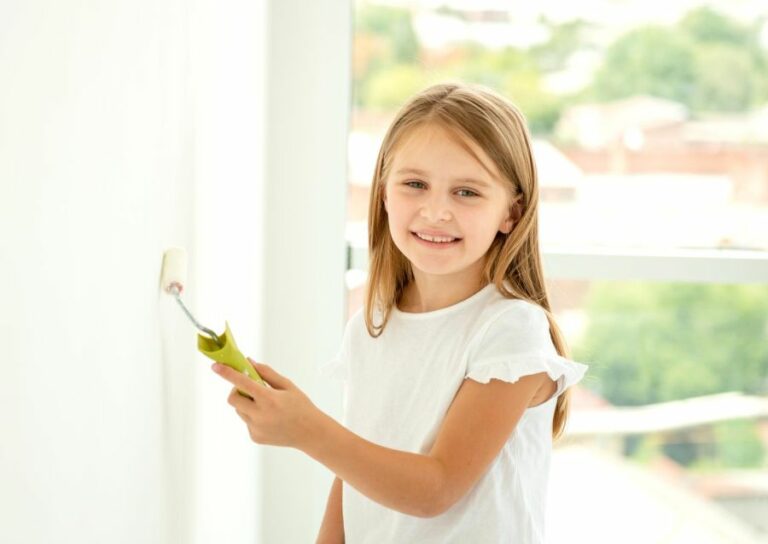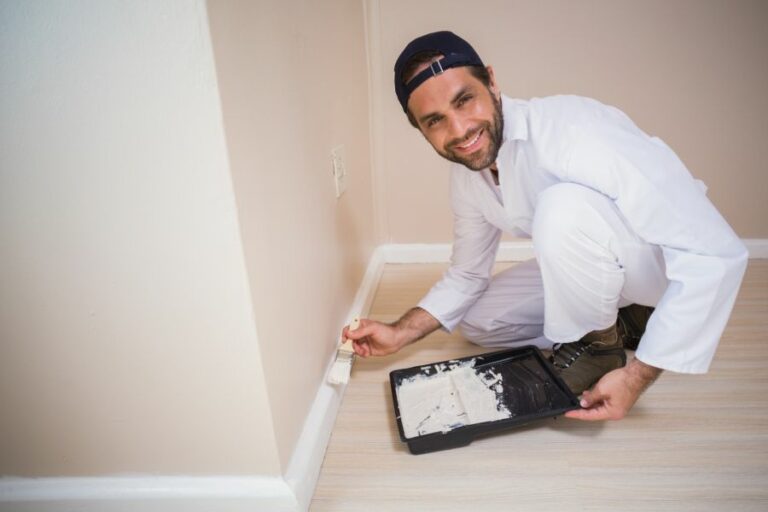Waterproofing Walls With Indoor Paint, 25 Things You Should Know
Tired of damp walls ruining your beautiful interiors? I’ve got the perfect solution for you! Waterproofing walls with indoor paint protects your home’s structure and maintains its aesthetic appeal. Dive into this discussion to explore how to achieve this and give your walls a fresh, durable makeover that stands the test of time!
Waterproofing walls with indoor paint:>
Waterproofing interior walls prevents moisture-related damage and maintains a healthy living environment. Applying specialized waterproofing paint, either water-based or solvent-based, can create a protective barrier against moisture. Proper preparation of the wall surface is essential for effective waterproofing, and it may involve repairing damage, cleaning, and priming the wall. Adequate ventilation and adherence to the manufacturer’s instructions ensure optimal results.

Don’t let moisture ruin your walls! Discover how indoor waterproofing paint can protect your interiors from dampness, mold, and unsightly water stains. Learn about the benefits, application process, and best practices to ensure your walls stay in pristine condition.
Read on to give your home the waterproof shield it deserves.
Contents
- 1 Waterproof Interior Walls Using Specialized Paint
- 2 Is Waterproof Paint Effective for Wall Protection?
- 3 Using Waterproof Paint for Interior Wall Protection
- 4 Achieving Waterproof Walls from the Inside with Paint
- 5 Top-Rated Indoor Waterproof Paint Options and Reviews
Waterproof Interior Walls Using Specialized Paint
• The Importance of Proper Waterproofing
Waterproofing walls is essential in order to prevent damage caused by moisture and dampness. These issues can lead to structural damage, mold growth, and poor indoor air quality.
The Environmental Protection Agency (EPA) stresses the need to address water and mold problems in order to maintain a healthy living environment. One effective method of waterproofing your walls is by using special waterproofing paint.
• Choosing the Right Waterproofing Paint
When considering waterproof paint options for your walls, you’ll find two main types: water-based and solvent-based. Both types work to create a protective barrier that repels water and prevents it from seeping into the wall. However, they do have some differences:
- Water-Based Paint: This type of paint is generally easier to work with, faster drying, and more environmentally friendly. It can be applied directly to the surface without the need for a primer, making it an ideal choice for DIY enthusiasts. In addition, water-based waterproofing paints are more breathable, allowing moisture trapped within the wall to evaporate and preventing mold growth.
- Solvent-Based Paint: Solvent-based waterproofing paints are considered to be more heavy-duty and durable compared to their water-based counterparts. While they may provide better waterproofing protection, they often require the use of a primer and have a stronger odor during application. The drying time for solvent-based paints may also be longer than water-based options.
Before you choose a paint, read the label carefully and check if the product is specifically designed for waterproofing purposes. Some paints may claim water resistance but may not provide the desired level of protection.
• Preparation: Essential for Effective Waterproofing
For optimal results, properly prepare the walls before applying the waterproofing paint. Follow these steps to ensure your walls are ready for the coating:
- Inspect the wall: Check for any existing signs of water damage, such as crumbling plaster, mold, or stains. If you find severe damage, you may need to repair or replace the damaged area before waterproofing.
- Clean the surface: Using a stiff brush or broom, remove any dirt, dust, or loose material from the wall. You may also use a diluted solution of mild detergent and water to wipe down the surface.
- Fill in cracks and holes: Identify any small cracks or holes and fill them with a suitable filler or sealant. This will help prevent water from seeping through and affecting your waterproofing efforts.
- Prime the wall: If required, apply a suitable primer to the wall, allowing it to dry completely before applying the waterproof paint. Priming helps to create a better bond between the paint and the surface and may be necessary for certain types of paints.
• Application: How to Properly Apply Waterproofing Paint
Once your surface has been adequately prepared, you can begin applying the waterproofing paint:
- Stir the paint thoroughly: Before applying the paint, make sure to mix it well. This guarantees that the waterproofing properties are evenly dispersed throughout the paint.
- Use the proper tools: For best results, use a brush, roller, or sprayer specifically designed for the type of paint you are using. Follow the manufacturer’s recommendations on the appropriate tools for their paint.
- Apply the first coat: Start by applying the paint in a thin, even coat. Be sure to cover the entire surface, paying special attention to areas where water is more likely to penetrate, such as joints, corners, and around pipes or outlets. Allow the first coat to dry completely before moving on to the second coat. The drying time will vary depending on the type of paint used.
- Apply additional coats: A second and sometimes even a third coat is usually required for optimal waterproofing protection. Make sure that each coat is applied evenly and allowed to dry completely before adding another layer.
- Inspect your work: After the final coat has dried for at least 24 hours, inspect your walls to ensure that the paint has adequately covered the entire surface and no areas have been missed.
• Additional Tips for Effective Waterproofing
- Always follow the manufacturer’s directions on the proper application and recommended number of coats for the specific waterproofing paint you choose.
- Work in a well-ventilated area, as paint fumes can be harmful if inhaled in high concentrations. Consider using a respirator while painting.
- Regularly invest time in maintaining your interior walls by inspecting them for signs of water damage or mold, especially in areas more prone to moisture, like kitchens, bathrooms, and basements.
By properly waterproofing your walls with indoor paint, you can both provide a protective barrier against moisture and enhance the durability and appearance of your interior spaces.
Is Waterproof Paint Effective for Wall Protection?
Waterproofing walls is essential to protect your property from water damage, mold, and dampness. One widely-discussed method of waterproofing is the use of waterproof paint.
• How Waterproof Paint Works
Waterproof paint is different from regular paint in its ability to create a watertight barrier on your walls. This barrier prevents water from penetrating the walls, protecting the materials and the structural integrity of your property.
Most waterproof paints are made of elastomeric materials, which allow the paint to expand and contract with your walls in varying temperatures, ensuring a lasting seal and consistent protection from water damage.
There are several types of waterproof paint available, ranging from latex-based to acrylic and silicone-based products.
Each type has its advantages and disadvantages, and selecting the appropriate one for your specific needs will depend on factors such as the materials you’re applying it to, existing paint and finishing, and weather conditions.
For a detailed guide on waterproof paint options, you may refer to the U.S. Department of Energy’s Building Technologies Office.
• Surface Preparation Is Crucial
Proper application of waterproof paint starts with proper surface preparation. If your walls have existing paint, you must first identify the type of paint that was previously used to ensure compatibility with the waterproof paint you plan to apply.
Certain waterproof paint products may not adhere well to specific types of existing paint.
An important part of surface preparation is cleaning the surface thoroughly to remove any dirt, debris, or mold. This step ensures proper adhesion of the waterproof paint and also helps to identify any cracks or damages on your walls that must be addressed prior to painting.
Any cracks, holes, or gaps must be repaired with appropriate sealants or patching compounds to prevent water intrusion. Similarly, if there’s any loose or flaking paint, it must be scraped off and sanded until the surface is smooth.
• Application of Waterproof Paint
Following the manufacturer’s instructions for your specific waterproof paint product is critical to ensure its effectiveness. Generally, it is recommended to apply at least two coats of waterproof paint to guarantee proper coverage and sealing.
The first coat should be applied using a brush or roller, and the second coat can be applied using the same method or with a sprayer for more even coverage.
Some waterproof paint products require a primer before the application of the main waterproof paint, particularly when painting on bare surfaces such as concrete or wood.
Be sure to check the manufacturer’s recommendations for primers or any other special instructions to maximize the effectiveness of your selected waterproof paint.
Allow ample time for the paint to dry between coats; most manufacturers recommend waiting at least 24 hours before applying the second coat.
Drying time may vary depending on factors such as temperature and humidity, so it’s essential to be patient and allow the paint to fully cure before deeming the job complete.
• Remember, Paint Is Not a Complete Solution
While waterproof paint can be an effective tool in waterproofing your walls, it is essential to remember that the paint itself cannot fix any underlying structural issues or damage resulting from water exposure.
It is necessary to address these issues before applying waterproof paint to ensure long-lasting protection for your property.
Be sure to monitor your walls and property consistently, checking for signs of water damage or any potential risks that could compromise the effectiveness of your waterproof paint.
An annual inspection by a professional can also be an excellent preventive measure to safeguard your walls against water damage.
In conclusion, while waterproof paint can be a reliable method of protecting your walls from water damage, it is essential to select the appropriate product, adequately prepare the surfaces, and apply the paint according to the manufacturer’s instructions.
Waterproof paint is not a substitute for addressing underlying structural issues or ongoing water intrusion problems, so it is crucial to keep an eye on your property and take preemptive measures to prevent water damage in the future.
Aspect | Description |
|---|---|
Waterproof Paint | Yes, you can waterproof a wall with special paint designed to prevent water penetration and resist moisture buildup |
Types of Waterproof Paint | Acrylic waterproof paint, cementitious waterproof paint, silicate-based waterproof paint, and elastomeric waterproof paint |
Application | Prepare the wall surface by removing dirt and debris, repair any cracks, and apply the waterproof paint according to the manufacturer’s instructions |
Factors to Consider | Type of wall material, existing moisture levels in the wall, indoor or outdoor wall, climate, and budget |
Using Waterproof Paint for Interior Wall Protection
Waterproofing your interior with paint is a viable option for protecting your home against moisture and dampness. By using waterproof paint, you can create a barrier that prevents the entry of water into the interior spaces of your home, consequently preserving the structural integrity of the building.
• Benefits of Waterproofing Interior with Paint
– Prevents Moisture Damage
Waterproof paint helps in protecting the walls, ceilings, and floors of your interior spaces from the detrimental effects of moisture. Moisture damage can lead to mold and mildew growth, causing unhealthy living conditions and even structural damage to the property.
– Enhances Durability of the Surface
By creating a barrier against moisture, waterproof paint enhances the durability of the surfaces in your home. This protective layer prevents the materials underneath from being exposed to moisture, reducing the risk of deterioration and prolonging the lifespan of your walls, ceilings, and floors.
– Aesthetic Appeal
Waterproof paint is available in a wide variety of colors and finishes to match the interior design of your home. You can effortlessly maintain the aesthetic appeal of your living spaces while also providing them with protection against moisture.
• Factors to Consider when Choosing Waterproof Paint
Before selecting a waterproof paint for your interior, there are several factors that should be taken into consideration.
– Type of Surface
Different surfaces may require different types of waterproof paint. For example, if you are waterproofing a concrete wall, you would need paint specifically designed for concrete surfaces. Ensure that the product you choose is compatible with the surface you intend to apply it on.
– Existing Moisture Problems
If you are already experiencing moisture issues in your home, such as mold growth or dampness, it is essential to address these problems before applying waterproof paint. Failure to do so could result in the paint not adhering properly, and the underlying issue will continue to worsen.
– Ventilation
Proper ventilation is crucial in maintaining a healthy indoor environment and preventing moisture buildup. Ensure that your home is well-ventilated before applying waterproof paint to prevent moisture-related issues in the future.
• Application Tips for Waterproofing Interior with Paint
For optimal results, it is vital to follow the correct application procedures when using waterproof paint. Here are some tips to help you achieve the best results:
– Surface Preparation
Before applying the paint, ensure that the surface is clean, dry, and free from any loose materials, such as dirt or peeling paint. You can use a wire brush or sandpaper to remove any loose materials and create a smooth surface for the paint to adhere to.
– Primer Application
Using a primer before applying the waterproof paint will improve adhesion and enhance the overall durability of the coating. Choose a primer that is specifically designed for use with waterproof paint.
– Application of Waterproof Paint
Follow the manufacturer’s instructions for the recommended number of coats and drying times between each coat. Use a high-quality brush, roller, or sprayer to apply an even layer of paint, covering the entire surface.
– Post-Painting Care
Once the paint has dried, ensure that your home remains well-ventilated to prevent moisture buildup that could undermine the effectiveness of the waterproof coating.
• Personal Recommendations
From experience, I recommend using reputable brands, such as Drylok or Zinsser, for waterproofing interior spaces with paint. These companies offer high-quality, reliable products that can help protect your home against moisture damage.
Check out this link from the Environmental Protection Agency for more information on preventing moisture problems in your home: EPA: A brief guide to mold, moisture, and your home
In conclusion, waterproofing your interior with paint can be an effective way to prevent moisture damage, enhance the durability of surfaces, and maintain the aesthetic appeal of your home.
By considering the factors outlined above and following proper application procedures, you can successfully protect your home against moisture-related issues.
Remember to keep your home well-ventilated and address any existing moisture problems before applying waterproof paint for the best results.
| Can you waterproof the interior with paint? | |
|---|---|
| Waterproof Paints | Yes, you can use waterproof paints like waterproof sealants and waterproofing primers designed for interior surfaces. |
| Application Surfaces | These waterproof paints can be applied on interior walls, floors, and ceilings to prevent water and moisture from seeping through. |
| Benefits | Waterproofing paint can protect the surface from damage caused by moisture, mold, and mildew, allowing for improved durability and longevity of the interior structure. |
| Limitations | Waterproof paint is not always a permanent solution and may require additional waterproofing techniques to ensure long-lasting protection, especially in areas with high humidity or heavy water exposure. |
Achieving Waterproof Walls from the Inside with Paint
Water damage is one of the most common and detrimental issues a homeowner can face. A damp or wet interior can lead to severe problems like mold, mildew, and structural damage.
Fortunately, there are ways to waterproof walls from the inside, providing a reliable protective barrier against water-related damage.
• Understanding The Sources Of Water Damage
Before discussing interior wall waterproofing methods, it’s essential to identify the possible sources of water damage. Water can infiltrate your home in different ways, such as through the roof, walls, foundation, and plumbing system.
To effectively waterproof your walls, you must understand the root cause of the problem.
For comprehensive information on the causes of water damage, the US Environmental Protection Agency (EPA) offers valuable resources.
• Interior Waterproofing Methods
There are several interior waterproofing methods to combat water intrusion. Below are the most widely used and recommended solutions based on my experience.
– Applying Waterproof Paint Or Coatings
One of the simplest and most cost-effective ways to waterproof interior walls is by applying waterproof paint or coatings. These products form a watertight barrier that repels moisture and prevents it from seeping through the walls.
Several options are available on the market, including acrylic, epoxy, and elastomeric products.
When selecting a waterproof paint, look for one that provides long-lasting protection, easy application, and excellent adhesion to various surfaces.
– Using Vapor Barriers
Vapor barriers are thick, flexible plastic sheets installed on the interior surface of walls, typically behind drywall or other finish materials. These barriers act as a shield, preventing moisture from penetrating the wall materials and reaching the interior living spaces.
Vapor barriers are often used in basements, crawl spaces, and other areas prone to moisture accumulation.
To achieve maximum effectiveness, ensure that the vapor barrier is installed correctly and that all seams are tightly sealed.
– Installing Interior Drainage Systems
In some cases, the best solution for waterproofing walls from the inside involves installing an interior drainage system. These systems collect water that enters the home, redirecting it away from the walls and foundation to a sump pump, which disposes of the water outside the house.
Interior drainage systems can be highly effective in keeping water away from walls, but they can also be relatively expensive and require professional installation.
– Injecting Waterproofing Materials Into Cracks And Gaps
Cracked or damaged walls are a common entry point for water. In these instances, it’s crucial to seal cracks and gaps with a waterproofing material, such as epoxy or polyurethane. Injecting these materials into the wall cavity fills the voids, creating a watertight seal that prevents water infiltration.
For best results, enlist the help of a professional contractor, as incorrect application of these materials can be both aesthetically unappealing and ineffective.
• Factors To Consider When Waterproofing Walls From The Inside
Before choosing an interior waterproofing method, several factors must be considered, including:
- The extent and severity of the water problem
- The type and construction of the walls
- The overall condition of the home, including the foundation and roof
- Budget limitations
- The need for professional assistance
Carefully assess your specific situation to determine the most effective and practical solution for your needs.
• The Importance Of Proper Maintenance And Prevention
In addition to interior waterproofing measures, it’s essential to maintain your home and implement preventative strategies to minimize the risk of water-related damage.
Regular inspections and maintenance of gutters, downspouts, plumbing systems, exterior grading, and other components can go a long way in protecting your home from water infiltration.
• Conclusion
While it may not always be possible to eliminate the risk of water damage completely, waterproofing walls from the inside can provide a valuable layer of protection.
By understanding the various methods available and selecting the most appropriate solution for your needs, you can effectively safeguard your home from the damaging effects of moisture.
Top-Rated Indoor Waterproof Paint Options and Reviews
Waterproof paints have become increasingly popular in recent years due to their ability to protect surfaces from moisture, dampness, and humidity. These paints are suitable for various indoor applications, including bathrooms, kitchens, basements, and other areas prone to moisture.
• Overview of Waterproof Paint
Waterproof paint is specially formulated to withstand the adverse effects of moisture and humidity in indoor spaces. It creates a protective barrier on the surface, preventing water penetration and the growth of mold and mildew.
Some waterproof paints even include antimicrobial agents that prevent the development of bacteria and fungal growth.
There are several types of waterproof paints, including acrylic, oil-based, epoxy, and latex options. To choose the best waterproof paint for your specific needs, consider factors such as the surface type, room conditions, and your personal aesthetic preferences.
– Acrylic Waterproof Paint
Acrylic waterproof paint is a popular option for its ease of use, quick drying time, and long-lasting protection. It offers excellent adhesion to various surfaces such as wood, concrete, or metal.
Acrylic paint is also water-based, which makes it easier to clean up and more environmentally friendly than oil-based options.
I recommend: Rust-Oleum Perma-White is an excellent choice for an acrylic waterproof paint because of its mold and mildew-proof finish, which is ideal for bathrooms and kitchens.
– Oil-Based Waterproof Paint
Oil-based waterproof paints provide a durable and robust finish, suitable for areas with high moisture levels. They are more resistant to water than acrylic paints, but they can be more challenging to apply and require a longer drying time.
Additionally, these paints contain higher levels of VOCs (Volatile Organic Compounds), making them less environmentally friendly.
I recommend: Valspar Duramax is a reliable option for oil-based waterproof paint, providing excellent coverage and long-lasting protection.
– Epoxy Waterproof Paint
Epoxy waterproof paints consist of a two-part system that includes a base and an activator. When combined, these components create a strong and durable coating resistant to water, chemicals, and abrasion.
Epoxy paints are ideal for concrete surfaces and are commonly used on basement walls and floors.
I recommend: EpoxyMaster offers a range of high-quality epoxy paint that provides top-notch waterproofing and protection for indoor concrete surfaces.
– Latex Waterproof Paint
Latex waterproof paint is a water-based option that is easy to apply, quick-drying, and offers excellent adhesion to a variety of surfaces. These paints are more flexible than oil-based or epoxy paints, allowing them to expand and contract with the surface to minimize cracking and peeling.
Additionally, latex paints produce fewer VOCs than oil-based options, making them a more environmentally friendly choice.
I recommend: BEHR Premium Waterproofing Paint provides excellent coverage and protection while offering a low-odor, low-VOC formula.
• Preparation and Application Tips
Before applying any waterproof paint, it’s crucial to prepare the surface properly. Clean the surface thoroughly, removing dirt, mold, or mildew. Repair any cracks, holes, or damaged areas, and ensure the surface is dry before applying the paint.
When applying the paint, use a brush, roller, or sprayer, ensuring even coverage and avoiding any drips or streaks.
Follow the manufacturer’s instructions regarding the number of coats required and the drying time between coats. Additionally, always provide adequate ventilation during application and drying to ensure safe use and prevent the buildup of harmful fumes.
• Maintaining Your Waterproof Paint Surface
Once you’ve applied waterproof paint to your indoor surface, regular maintenance will help extend its lifespan and maintain its effectiveness. Be sure to clean the surface routinely to remove dirt, dust, and mildew.
Inspect your painted surface regularly for signs of wear or damage, and reapply the paint as needed to guarantee continuous protection against moisture.
• Final Thoughts
Choosing the best waterproof paint for indoor use depends on several factors, including the type of surface, the specific moisture-related issues you face, and your personal preferences.
Weighing the pros and cons of different waterproof paint options will help you select the best paint type for your needs, while proper application and maintenance techniques will ensure long-lasting protection.
For more information on waterproof paint options and best practices, be sure to consult resources from reputable organizations like Paint Quality Institute and the Environmental Protection Agency.
Brand | Product Name | Description | Application |
|---|---|---|---|
Rust-Oleum | Zinsser Perma-White Mold & Mildew-Proof Interior Paint | A self-priming paint specifically designed to prevent mold and mildew growth in high-humidity areas. | Walls, ceilings, and trim in kitchens, bathrooms, and basements |
KILZ | KILZ Interior/Exterior Basement and Masonry Waterproofing Paint | A waterproofing paint that creates a waterproof barrier on interior and exterior surfaces, preventing water penetration. | Basement walls, masonry surfaces, and retaining walls |
Drylok | Drylok Extreme Masonry Waterproofer | A high-performance waterproofing paint that withstands hydrostatic pressure and prevents water seepage. | Walls, floors, and ceilings in basements and other masonry surfaces |
Behr | Behr Premium Interior/Exterior Direct-To-Metal Paint | A durable, corrosion-resistant paint that provides a waterproof finish on properly prepared interior and exterior metal surfaces. | Metal doors, windows, railings, and other metal surfaces |
Sherwin-Williams | Sherwin-Williams Duration Home Interior Acrylic Latex Paint | A high-quality, durable interior paint that provides a stain-resistant, moisture-resistant, and mildew-resistant finish. | Walls, ceilings, and doors in living rooms, bedrooms, kitchens, and bathrooms |







